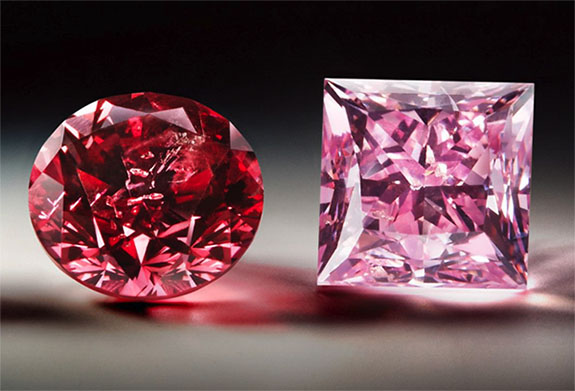Aussie Researchers Define Three Key Factors That Create Coveted Pink Diamonds
For 37 years until its closing in 2020, Rio Tinto’s Argyle Mine in Australia produced between 90% and 95% of the world’s pink and red diamonds. Since diamond mines exist all over the world, scientists struggled to understand why nearly all of the blush diamonds were concentrated in one location.

Well, now researchers at Perth-based Curtin University believe they have the answer. And it all comes down to a mix of three key factors. Sure, you need diamond's key element — carbon — along with the massive force and heat generated by colliding tectonic plates. But the secret ingredient is continental "stretching."
Lead researcher Dr. Hugo Olierook from Curtin University's John de Laeter Centre said the "stretching" of landmasses created gaps in the Earth’s crust through which diamond-carrying magma could rise to the surface. What's more, the "stretching" also altered the diamond's lattice structure deep within the Earth.
Unlike yellow or blue diamonds that owe their colour to the presence of nitrogen or boron in their chemical makeup, pink and red diamonds owe their colour to the effects of intense pressure, heat and twisting. These factors caused distortions in the diamond’s crystal lattice that influence the way the gem absorbs green light, thus reflecting a pink or red hue.
As The New York Times explained, "The colour comes from the warping of the gem’s crystal lattice under intense pressure. While all diamonds form under pressure, even more force turns once-clear diamonds colourful. A slight extra squeeze turns a diamond pink, and a hard squash turns it brown."
“By using laser beams smaller than the width of a human hair on rocks supplied by Rio Tinto, we found Argyle to be 1.3 billion years old, which is 100 million years older than previously thought, meaning it would likely have formed as a result of an ancient supercontinent breaking apart,” Dr. Olierook said.
Olierook identified Argyle as the point where the Kimberley region and the rest of northern Australia smashed together.
"And that sort of collision creates a damaged area or ‘scar’ in the land that will never fully heal," he added. "While the continent that would become Australia didn’t break up, the area where Argyle is situated was stretched, including along the scar, which created gaps in the Earth’s crust for magma to shoot up through to the surface, bringing with it pink diamonds."
Having identified the special ingredients that create pink and red diamonds, Dr. Olierook and his team believe it will be be possible — yet still very challenging — to find the "next Argyle" in the global hunt for new deposits.
“Most diamond deposits have been found in the middle of ancient continents because their host volcanoes tend to be exposed at the surface for explorers to find,” Dr. Olierook said. "Argyle is at the suture of two of these ancient continents, and these edges are often covered by sand and soil, leaving the possibility that similar pink diamond-bearing volcanoes still sit undiscovered, including in Australia.”
The team's findings were published Tuesday in the journal Nature Communications.

Well, now researchers at Perth-based Curtin University believe they have the answer. And it all comes down to a mix of three key factors. Sure, you need diamond's key element — carbon — along with the massive force and heat generated by colliding tectonic plates. But the secret ingredient is continental "stretching."
Lead researcher Dr. Hugo Olierook from Curtin University's John de Laeter Centre said the "stretching" of landmasses created gaps in the Earth’s crust through which diamond-carrying magma could rise to the surface. What's more, the "stretching" also altered the diamond's lattice structure deep within the Earth.
Unlike yellow or blue diamonds that owe their colour to the presence of nitrogen or boron in their chemical makeup, pink and red diamonds owe their colour to the effects of intense pressure, heat and twisting. These factors caused distortions in the diamond’s crystal lattice that influence the way the gem absorbs green light, thus reflecting a pink or red hue.
As The New York Times explained, "The colour comes from the warping of the gem’s crystal lattice under intense pressure. While all diamonds form under pressure, even more force turns once-clear diamonds colourful. A slight extra squeeze turns a diamond pink, and a hard squash turns it brown."
“By using laser beams smaller than the width of a human hair on rocks supplied by Rio Tinto, we found Argyle to be 1.3 billion years old, which is 100 million years older than previously thought, meaning it would likely have formed as a result of an ancient supercontinent breaking apart,” Dr. Olierook said.
Olierook identified Argyle as the point where the Kimberley region and the rest of northern Australia smashed together.
"And that sort of collision creates a damaged area or ‘scar’ in the land that will never fully heal," he added. "While the continent that would become Australia didn’t break up, the area where Argyle is situated was stretched, including along the scar, which created gaps in the Earth’s crust for magma to shoot up through to the surface, bringing with it pink diamonds."
Having identified the special ingredients that create pink and red diamonds, Dr. Olierook and his team believe it will be be possible — yet still very challenging — to find the "next Argyle" in the global hunt for new deposits.
“Most diamond deposits have been found in the middle of ancient continents because their host volcanoes tend to be exposed at the surface for explorers to find,” Dr. Olierook said. "Argyle is at the suture of two of these ancient continents, and these edges are often covered by sand and soil, leaving the possibility that similar pink diamond-bearing volcanoes still sit undiscovered, including in Australia.”
The team's findings were published Tuesday in the journal Nature Communications.

